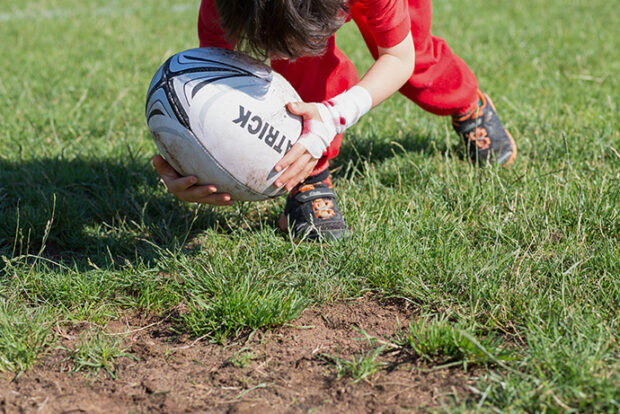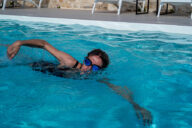Is the sports fanatic being disguised by a normal, healthy and acceptable lifestyle, but carefully hiding much more, by a framework of words, systems and terminology?
Is it possible that there is only one voice of truth that speaks back to this ‘framework of words, systems and terminology’ and that this voice is the voice of the physical body?
Recently I was in discussion about people that are heavily into sports. There seems to be nothing that can shift the almost manic behaviour of constant stimulation and unrest. You can see how their bodies are being run ragged with a force that is driving and pushing to the absolute limit. The only thing that stops the momentum, is injury and hospitalisation, and then there is a breather – the body actually gets a chance to rest.
This whole discussion began through the topic of injury, and observing repetitive ongoing occurrences from one month to the next: only each time, the injuries seem to get worse, with longer recovery periods taking place. Why are we not joining the dots – correlating the ill-gotten movement of push and drive, and the end point resulting in injury? What is the missing piece? Where is that push coming from and what is the purpose behind it?
We could ask, – how can one receive so many injuries and end up permanently damaged, through a healthy competitive and friendly team sport? Team building and camaraderie is what we say it’s all about … or is it destruction in the guise of a friendly game of sport?
Have you noticed how there is special code language for aggression and violence, all in the name of sport? Or is it all ok because it’s been given a special name because the vicious attack has a special terminology and escapes the violence banner hiding in the name of sports and the rules of the game?
Following are some examples of sports terminology and how it translates into body language:
Ice Hockey
To ‘body check’ the opponent means to crash into someone while passing by, in the aim to destabilise, to overpower them physically to get the puck off them. How is it ever ok to deliberately target someone and forcefully plough into their body, to hurt and harm? This is called ‘contact sport’.
Soccer
To ‘chop’ your opponent means to go for their legs not for the ball, with the intention to hack and maim. Have you ever heard the sound of a football boot hitting flesh and bone, on the field at close range, in full force? It is something truly horrible to hear and feel in the body. It is an absolute violation of all that is true in our nature and the love that we are and come from.
AFL Football
‘Sledging’ means to say disgusting things under your breath, loud enough to be heard, at the opposition – to provoke, to destabilise, to debase, to harm psychologically.
It’s ok if you ‘tackle below the belt’ the rules say. This means it’s ok to go for an opponent if it’s below the belt; to throw oneself onto another player, grab at the legs or hips, wherever they can be grabbed onto, while in mid-air throwing themselves and dropping the opposing player to the ground with a crash. There is no self-preservation here, running kamikaze at the opponent and you both go crashing to the ground, with injury imminent.
Netball
Goal Attack, Wing Attack, Goal Defence, Wing Defence. Look at the names for the playing positions. This is a so-called ladies’ sport that is clearly a line-up of battle positions.
What is it to be a lady, to express true strength and honouring of the gentleness and delicacy of the female form? What happened that we have gone to ‘attack mode’ and conveniently calling this waywardness a ladies’ sport, a ladies’ game?
There are many more examples that can be given, covering all the different sports that exist, but this is giving a basic example of what sport is made up of. This is the language of sport, with each code designed and given specific terminology and rules to cover up viciousness and aggression and to then call it sport.
Then there are the ‘safer’ sports options. For example, soccer is supposed to be a safer sport, and many parents opt for soccer as the safer option rather than football, because they feel there is less violence allowed in the game compared to Aussie rules football. There is still violence, however, this is supposedly choosing the lesser aggression and settling for the lesser degree of damage as more acceptable.
Why are we diluting what is the truth and accepting the lie of supposed lesser harm as acceptable?
Is any sport really better or safer? There are still ruptured ligaments, sprained or broken ankles, broken limbs, dislocated knees, broken collar bones, pulled hamstrings, pulled groins, shin splints, corked muscles, concussion, and the list goes on. Inevitably the body breaks, it was not designed for such an onslaught of relentless abuse.
The body in complete disregard, with the persistent striving for approval, for recognition, for the desire to be seen as a star on the field of play. Very simply, there is a ‘back stop’ behind every player. Whether they realise it or not, this backstop is the body – it innately knows, and is the body of truth, the evidence of what has been lived and moved through the choices made.
How many times have you heard it was an ‘accident’ and if it wasn’t an accident, it was a deliberate attack? The accident can be a way of writing the incident off, not going there, not questioning what happened, just accepting the damage and walking away. The deliberate attack can be when you see what has happened, you call it out and question it and then it escalates to retaliation and further violence and aggression. The retaliation may not be immediate, it can simmer and wait for the next time, the next opportunity and it may be a few games later, depending on when the teams meet again. i.e., “I didn’t do anything, I was just running with the ball and they went for me.” Maybe you were the aggressor in the last game and forgot all about the retaliation that was coming and on order, for the next round – a grudge match; or was it that you were just too good and the jealousy kicked in, so you had to be cut down? Whichever way it was, this is sport.
I recall a story about a football player cracking his skull and face while playing. He ended up in hospital with metal plates in his head because his skull and face literally broke. After he had recovered or was deemed fit to play, he ran out on the field, with a helmet on his head. His supporters were praising him for the bravery of coming back after such an injury. The opposing crowd had a completely different take on the matter, they booed him and called him a woos and weak for wearing a helmet to protect his head. There were all kinds of horrible things hurled at him and around him. It was a complete media frenzy, the next hot topic to gossip about, no care factor of the damage that was delivered with those horrible words designed to slay.
Why did he go out to play?
Maybe it could have been that he was owned by the club, was under contract and was forced to after being deemed fit to play by the club’s doctors.
Or could it have been that he was a mad sports fanatic, in complete unrest and wanting to keep smashing himself, proving himself as being tough as nails, and what better arena than out in the public for all to see and get the recognition that was so badly needed?
What part of us as a society feels that it is ok to go out there and play after such a horrific injury, and completely disregard the body? Whatever that part of us is, it certainly cannot feel the pain, or at minimum is forced or chooses to override it, of the decision to continue to play.
Is part of the overriding the ideal of an amazing golden opportunity offered, to play for a major elite sports team, all your dreams coming true; not only your dreams, but your family’s dreams as well, waiting in anticipation of the riches and security that comes with the status of being a sports star? Do we even read the fine print of the contract, is there even a care factor about the fine print when such golden offers are presented? What are the agreements, what are we signing for?
I recall a TV show with a theme song called ‘It’s more than a game’. It sure is more than a game, it’s an aggressive onslaught on a mass scale across young and old. There is no discrimination, it is an open arena for all to play whether you are a spectator, a linesman, an umpire, part of the crowd, a team physiotherapist, team doctor. No matter what part you play, you enjoin in the game.
Think about it – in the sentences above, medical therapists are mentioned. In fact there is no question that the services of such practitioners are needed when illness or injury sets in. However, why would such services be needed in a so called, healthy team sport game that is promoted as a healthy choice and lifestyle?
It’s kind of like the army having its own medics’ team – you have the soldiers go out to battle and once they are wounded, they retreat back to the medics’ team, waiting to patch them up so they can go back out again for another round. This is repeated until the body cannot be patched up anymore. Both the soldier and the athlete are then forced to retire, no longer physically able to continue in the battle of winning anymore. And so then, they become a hero, a champion, and all kinds of accolades may be given in recognition, but what is the bodily damage? Was it worth it?
Are we any different to the Gladiator battles in the ancient arenas, with the crowd jeering for more blood and action? Perhaps we are a little more refined in the way things are done these days, not so in your face and obvious.
This is elite sport, sought after lucrative contracts and deals that so many young people strive for, viewing it as a success in life, a way to show that they have really made it, a successful athlete, a success in life. The profitable deals are there for all the supporters of this whole organised system, – it’s big business and everyone has got on the band wagon. It doesn’t stop at exclusive elite team therapists anymore: this was just the beginning and has now filtered through to junior leagues, state leagues, all kinds of leagues, as long as you have the one common denominator of sport in play.
Regardless of this ephemeral game at play, the inescapable body of truth is there to speak volumes, this one voice of truth that speaks back to this systemised framework of assault and abuse – the voice that is the physical body.
Further reading:
Watching sport
Girls and Contact Sports: What are We not Discussing?
Sport, Competition and Fiery Debate





